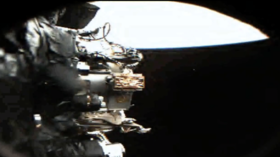India becomes fourth nation to achieve space landmark

The Indian Space Research Organisation (ISRO) successfully completed the docking of SpaDeX satellites in space on Thursday, becoming the fourth country to achieve such a feat.
The achievement is seen as vital for the south Asian country’s future missions, including the construction of its own space stations, and sending an Indian to the Moon.
“India docked its name in space history! Proud to witness this moment!” ISRO said in a post on X.
The Space Docking Experiment (SpaDeX) mission was launched on December 30. The primary objective, according to ISRO, was to develop and demonstrate the technology required for the rendezvous, docking, and undocking of two small spacecraft in a low-Earth circular orbit.
The historic moment occurred just days after the space agency’s trial run on January 12, when it brought the two spacecraft within three meters of each other before safely moving them back to a secure distance, the agency said.
SpaDeX Docking Update:SpaDeX satellites holding position at 15m, capturing stunning photos and videos of each other! 🛰️🛰️ #SPADEX#ISROpic.twitter.com/RICiEVP6qB
— ISRO (@isro) January 12, 2025
Prime Minister Narendra Modi, who closely monitors his country’s space missions, congratulated ISRO on the success. “It is a significant stepping stone for India’s ambitious space missions in the years to come,” he said in a post on X.
ISRO described the SpaDeX mission as a “cost-effective technology demonstrator” that was crucial for advancing India’s space ambitions. These include sending the first Indian astronaut to the Moon by 2040, retrieving a lunar sample, and developing and operating the country’s own space station.
🌟 PSLV-C60/SPADEX Mission Update 🌟Visualize SpaDeX in Action!🎞️ Animation Alert:Experience the marvel of in-space docking with this animation! 🌐 Click here for more information: https://t.co/jQEnGi3ocFpic.twitter.com/djVUkqXWYS
— ISRO (@isro) December 27, 2024
Docking capability is crucial for the construction and operation of space stations, as it allows modules to be connected in orbit, facilitating the assembly of larger structures. It also enables the transfer of crew, supplies and equipment between modules or visiting spacecraft, thereby rendering a functional and sustainable space station.
Docking technology is also essential for in-space satellite servicing, enabling the repair and refueling of satellites, extending their operational lifespans. The SpaDeX mission utilized in-space docking technology, which involves precise maneuvering and control systems to connect two spacecraft in orbit, ISRO said.
Last year, the country’s space agency achieved several milestones, including multiple satellite launches, testing of the Reusable Launch Vehicle (RLV) technology. It also began the assembly of the Human Rated Launch Vehicle Mark-3 (HLVM3) for its Gaganyaan human spacelift mission’s maiden uncrewed flight.













